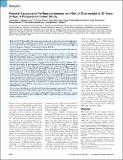| dc.contributor.author | Halldorsson, Thorhallur I. | |
| dc.contributor.author | Rytter, Dorte | |
| dc.contributor.author | Haug, Line Småstuen | |
| dc.contributor.author | Bech, Bodil Hammer | |
| dc.contributor.author | Danielsen, Inge | |
| dc.contributor.author | Becher, Georg | |
| dc.contributor.author | Henriksen, Tine Brink | |
| dc.contributor.author | Olsen, Sjurdur F. | |
| dc.date.accessioned | 2013-04-01T20:27:34Z | |
| dc.date.issued | 2012 | |
| dc.identifier.citation | Halldorsson, Thorhallur I., Dorte Rytter, Line Småstuen Haug, Bodil Hammer Bech, Inge Danielsen, Georg Becher, Tine Brink Henriksen, and Sjurdur F. Olsen. 2012. Prenatal exposure to perfluorooctanoate and risk of overweight at 20 years of age: a prospective cohort study. Environmental Health Perspectives 120(5): 668-673. | en_US |
| dc.identifier.issn | 0091-6765 | en_US |
| dc.identifier.uri | http://nrs.harvard.edu/urn-3:HUL.InstRepos:10484029 | |
| dc.description.abstract | Background: Perfluoroalkyl acids are persistent compounds used in various industrial -applications. Of these compounds, perfluorooctanoate (PFOA) is currently detected in humans worldwide. A recent study on low-dose developmental exposure to PFOA in mice reported increased weight and elevated biomarkers of adiposity in postpubertal female offspring.: Objective: We examined whether the findings of increased weight in postpubertal female mice could be replicated in humans. Methods: A prospective cohort of 665 Danish pregnant women was recruited in 1988–1989 with offspring follow-up at 20 years. PFOA was measured in serum from gestational week 30. Offspring body mass index (BMI) and waist circumference were recorded at follow-up (n = 665), and biomarkers of adiposity were quantified in a subset (n = 422) of participants. Results: After adjusting for covariates, including maternal pre-pregnancy BMI, smoking, education, and birth weight, :in utero exposure to PFOA was positively associated with anthropometry at 20 years in female but not male offspring. Adjusted relative risks comparing the highest with lowest quartile (median: 5.8 vs. 2.3 ng/mL) of maternal PFOA concentration were 3.1 [95% confidence interval (CI): 1.4, 6.9] for overweight or obese (BMI ≥ 25 kg/m2) and 3.0 (95% CI: 1.3, 6.8) for waist circumference > 88 cm among female offspring. This corresponded to estimated increases of 1.6 kg/m2 (95% CI: 0.6, 2.6) and 4.3 cm (95% CI: 1.4, 7.3) in average BMI and waist circumference, respectively. In addition, maternal PFOA concentrations were positively associated with serum insulin and leptin levels and inversely associated with adiponectin levels in female offspring. Similar associations were observed for males, although point estimates were less precise because of fewer observations. Maternal perfluorooctane sulfonate (PFOS), perfluorooctane sulfonamide (PFOSA), and perfluorononanoate (PFNA) concentrations were not independently associated with offspring anthropometry at 20 years. Conclusions: Our findings on the effects of low-dose developmental exposures to PFOA are in line with experimental results suggesting obesogenic effects in female offspring at 20 years of age.: | en_US |
| dc.language.iso | en_US | en_US |
| dc.publisher | National Institute of Environmental Health Sciences | en_US |
| dc.relation.isversionof | doi:10.1289/ehp.1104034 | en_US |
| dc.relation.hasversion | http://www.ncbi.nlm.nih.gov/pmc/articles/PMC3346773/pdf/ | en_US |
| dash.license | LAA | |
| dc.title | Prenatal Exposure to Perfluorooctanoate and Risk of Overweight at 20 Years of Age: A Prospective Cohort Study | en_US |
| dc.type | Journal Article | en_US |
| dc.description.version | Version of Record | en_US |
| dc.relation.journal | Environmental Health Perspectives | en_US |
| dash.depositing.author | Olsen, Sjurdur F. | |
| dc.date.available | 2013-04-01T20:27:34Z | |
| dc.identifier.doi | 10.1289/ehp.1104034 | * |
| dash.contributor.affiliated | Olsen, Sjurdur | |


